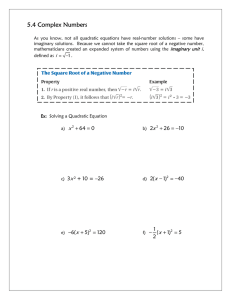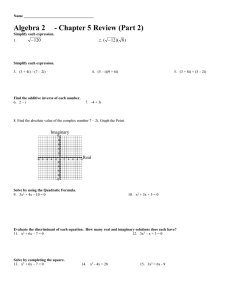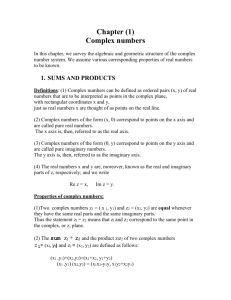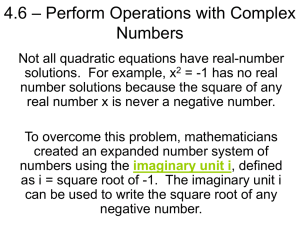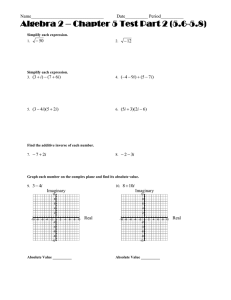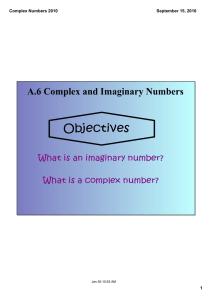5. The algebra of complex ... We use complex numbers for more purposes ...
advertisement
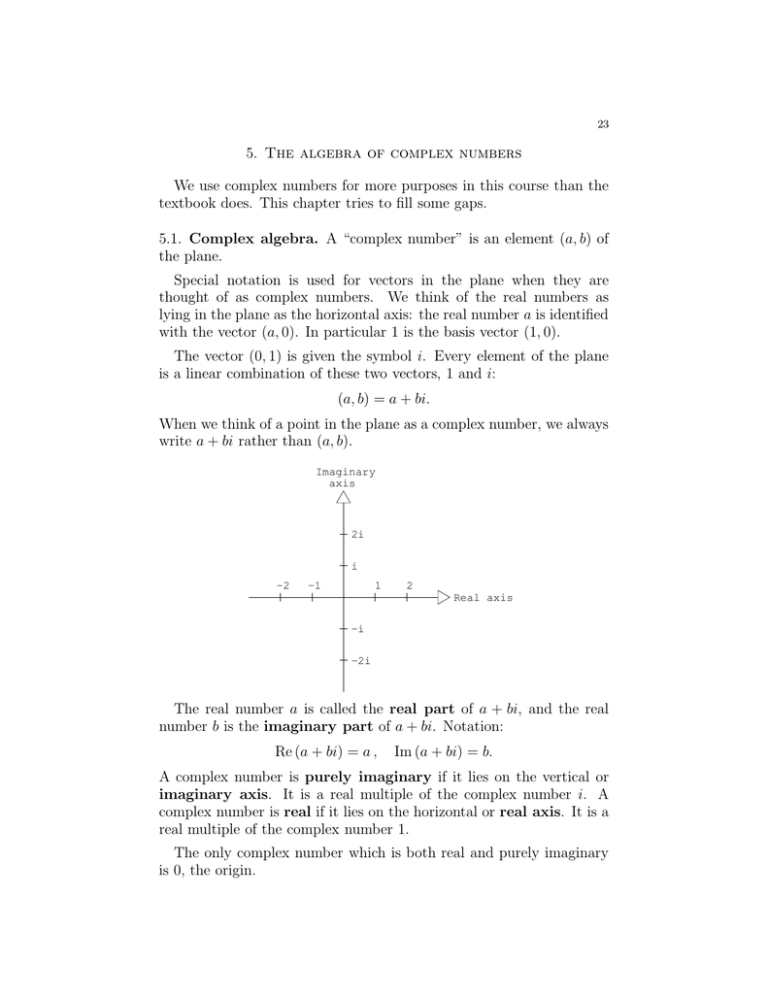
23 5. The algebra of complex numbers We use complex numbers for more purposes in this course than the textbook does. This chapter tries to fill some gaps. 5.1. Complex algebra. A “complex number” is an element (a, b) of the plane. Special notation is used for vectors in the plane when they are thought of as complex numbers. We think of the real numbers as lying in the plane as the horizontal axis: the real number a is identified with the vector (a, 0). In particular 1 is the basis vector (1, 0). The vector (0, 1) is given the symbol i. Every element of the plane is a linear combination of these two vectors, 1 and i: (a, b) = a + bi. When we think of a point in the plane as a complex number, we always write a + bi rather than (a, b). Imaginary axis 2i i −2 1 −1 2 Real axis −i −2i The real number a is called the real part of a + bi, and the real number b is the imaginary part of a + bi. Notation: Re (a + bi) = a , Im (a + bi) = b. A complex number is purely imaginary if it lies on the vertical or imaginary axis. It is a real multiple of the complex number i. A complex number is real if it lies on the horizontal or real axis. It is a real multiple of the complex number 1. The only complex number which is both real and purely imaginary is 0, the origin. 24 Complex numbers are added by vector addition. Complex numbers are multiplied by the rule i2 = −1 and the standard rules of arithmetic. This means we “FOIL” out products. For example, (1 + 2i)(3 + 4i) = 1 · 3 + 1 · 4i + (2i) · 3 + (2i) · (4i) = · · · —and then use commutativity and the rule i2 = −1: · · · = 3 + 4i + 6i − 8 = −5 + 10i. The real part of the product is the product of real parts minus the product of imaginary parts. The imaginary part of the product is the sum of the crossterms. We will write the set of all real numbers as R and the set of all complex numbers as C. Often the letters z, w, v, and s, and r are used to denote complex numbers. The operations on complex numbers satisfy the usual rules: Theorem. If v, w, and z are complex numbers then z+0= z, v + (w + z) = (v + w) + z , z·1 =z, v(wz) = (vw)z , w + z = z + w, wz = zw (v + w)z = vz + wz. This is easy to check. The vector negative gives an additive inverse, and, as we will see below, every complex number except 0 has a mul­ tiplicative inverse. Unlike the real numbers, the set of complex numbers doesn’t come with a notion of greater than or less than. ≤ Exercise 5.1.1. Rewrite ((1 + 3i)/2)3 and (1 + i)4 in the form a + bi. 5.2. Conjugation and modulus. The complex conjugate of a com­ plex number a + bi is the complex number a − bi. Complex conjugation reflects a complex number across the real axis. The complex conjugate of z is written z̄: a + bi = a − bi Theorem. Complex conjugation satisfies: z¯ = z, w + z = w̄ + z̄, wz = w̄z. ¯ 25 A complex number z is real exactly when z̄ = z and is purely imaginary exactly when z̄ = −z. The real and imaginary parts of a complex number z can be written using complex conjugation as (1) Re z = z + z̄ , 2 Im z = z − z̄ . 2i Again this is easy to check. Exercise 5.2.1. Show that if z = a + bi then zz̄ = a2 + b2 . This is the square of the distance from the origin, and so is a nonneg­ ative real number, nonzero as long as z = ∈ 0. Its nonnegative square root is the absolute value or modulus of z, written ≤ ≤ |z| = zz̄ = a2 + b2 . Thus (2) zz̄ = |z |2 Exercise 5.2.2. Show that |wz | = |w||z|. Since this notation clearly extends its meaning on real numbers, it follows that if r is a positive real number then |rz | = r |z |, in keeping with the interpretation of absolute value as distance from the origin. Any nonzero complex number has a multiplicative inverse: as zz̄ = |z|2 , z −1 = z/ ¯ |z|2 . If z = a + bi, this says 1 a − bi = 2 (a + bi) a + b2 This is “rationalizing the denominator.” Exercise 5.2.3. Compute i−1 , (1 + i)−1 , and terms of |z |? 1+i . What is |z −1 | in 2−i Exercise 5.2.4. Since rules of algebra hold for complex numbers as well as for real numbers, the quadratic formula correctly gives the roots of a quadratic equation x2 + bx + c = 0 even when the “discriminant” b2 −4c is negative. What are the roots of x2 +x+1? Of x2 +x+2? The quadratic formula even works if b and c are not real. Solve x2 +ix+1 = 0. 26 5.3. The fundamental theorem of algebra. Complex numbers rem­ edy a defect of real numbers, by providing a solution for the quadratic equation x2 + 1 = 0. It turns out that you don’t have to worry that someday you’ll come across a weird equation that requires numbers even more complex than complex numbers: Fundamental Theorem of Algebra. Any nonconstant polynomial (even one with complex coefficients) has a complex root. Once you have a single root, say r, for a polynomial p(x), you can divide through by (x − r) and get a polynomial of smaller degree as quotient, which then also has a complex root, and so on. The result is that a polynomial p(x) = axn + · · · of degree n factors completely into linear factors over the complex numbers: p(x) = a(x − r1 )(x − r2 ) · · · (x − rn ). MIT OpenCourseWare http://ocw.mit.edu 18.03 Differential Equations���� Spring 2010 For information about citing these materials or our Terms of Use, visit: http://ocw.mit.edu/terms.
